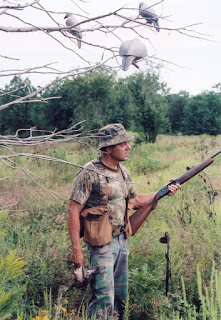Once
years ago I was hunting with the publisher-owner of Gun Dog Magazine, who was
from Iowa. Back then there was no
dove season in Iowa; we were
hunting a harvested grain field in Missouri and he had a friend
along. His friend sat at the edge
of the field and killed five doves with his first five shots. Then he commented, “I always heard
doves were hard to hit, but heck, this is no challenge at all.”
The
fourth member of our group was a Corps of Engineer Ranger who had hunted doves
since he was a boy. He could scarcely be heard from his hiding place a few
yards away. But I smiled when I heard him mutter to himself… “He’ll regret
saying that!”
Sure
enough, our newcomer from Iowa missed the next 7 shots. That’s a lot the way
dove hunting is. Sometimes they
aren’t too hard to hit, and then you see a few winged acrobats and wish you’d
have a bigger shot pattern.
Many
of the old timers I knew were river-men who hunted most everything… but not
doves. Some of that attitude came
from believing that God had designated the dove as a bird of peace. When
grizzled old veteran hunters and trappers felt that way it was usually because
they had mothers and wives who recoiled against the idea of shooting a dove. But usually they just didn’t have the
guns to do it.
In
that time I remember many of them never bought a full box of shotgun shells.
You might get 10 or 12 but never a full box. It cost too much.
And there was common sense to it.
You didn’t go out there with a Winchester model-97 long-barreled pump
shotgun with a full choke in it and shoot at doves. There was no good reason to spend 2 or 3 shells on a bird
that only provide one man about 1/5th of a meal, even if he had poke
salad and beans and cornbread to go with it. Dove hunters sort of sprang from quail hunting… men who used
open-choked short-barreled shotguns and a little bit of money to buy shells
with. They could afford game vests
and supporting a good setter or pointer, which required more food and upkeep
than a beagle or a coonhound.
But
personally I am losing interest in dove hunting because on September 1 every
year is hot and muggy and my hunting partner, Bolt the Labrador, don’t like getting
out there in the weeds if there is no water close. Now, hunting over water-holes in the evening is another
story. We don’t mind that so much,
and we might do that a couple of weeks after everyone else has quit hunting
them.
But
I have seen a few dove fledglings in nests in early September. If I were setting dove seasons in the
southern reaches of the Midwest I would set the dove season’s opening date back
to September 21. It makes sense,
fewer nestlings wasted, a cooler time when more doves are migrating down from
the north. If that makes sense to
you, you might see when the season on doves ends and make a late season trip to
a grain field or water hole.
Before
I go I just have to pass on a conversation I had with a lady who wasn’t all
that fond of hunters. She said
that I ought to be ashamed of myself for hunting God’s bird of peace, the dove.
I told her that I was indeed a little ashamed of that, but she had morning
doves confused with the birds of peace discussed in the Bible. They were different birds, I assured
her, but not a lot different than the quail God provided for the Israeli’s in
the desert. Those
birds of peace were white and they didn’t get trichomoniasis. She looked at me for a minute and then
wanted to know what that big word meant. I told her about that, an awful mass
which grows inside the throat of mourning doves and their fledglings, which cause
them to die a slow death because they can’t swallow food. She looked skeptical, so I told her
about how some northern doves actually do not migrate and many freeze to death
or have toes frozen off.
I
told her how our Great Creator allows doves to be caught and eaten by hawks and
cats while they were still alive.
“You don’t have any cats do you?” I asked. She didn’t answer.
Then I said, “You know ma’m, doves can’t feed on standing grain, they
have to have grain on the ground to walk around and feed that way. So I am going to buy a bunch of wheat
and sunflower seed to feed them through the awful cold months of the winter,
and if you would like to help them just give me a twenty dollar bill and I’ll
use it for more seed.” She looked
at me and smiled a little and said, “You are a bit of a shyster aren’t you?”
I
told her that indeed I was, and she told me she was going to get on the
computer and find out if all that stuff I said was the truth. But when I asked if she’d like to try
some baked doves with gravy, she kindly declined…. and frowned a bit at the
thought of it.
OUTDOOR
NOTES… Cool weather will send the blue-winged teal into the lower
Midwest. There is a special
hunting season for them in September.
They are the earliest migrators of the waterfowl species, a harbinger of
the true fall season.



No comments:
Post a Comment